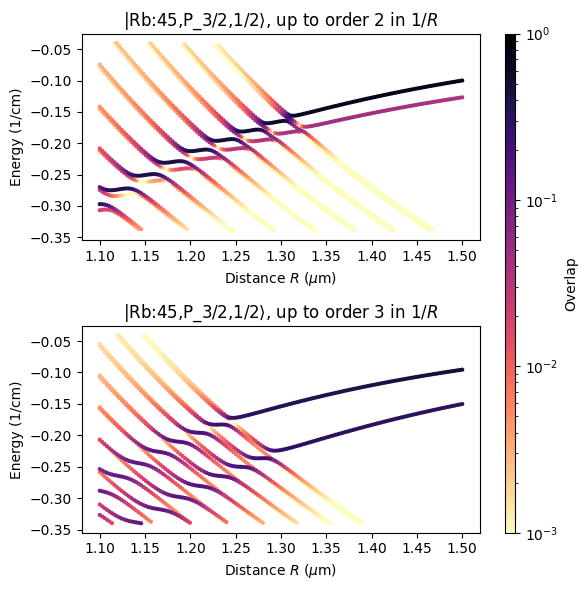Rydberg Atom Ion Interaction
Here we look at the interacton between a single ion and a Rydberg atom. More details regarding the theory can be found in A. Duspayev et al., Phys. Rev. Research 3, 023114 (2021) or M. Deiß et al., Atoms 9, 2 (2021). The inernuclear axis is aligned with the z-direction and the interaction is expanded in multipolar terms. With this choice of coordinate system, the interaction potential is rotationally symmetric around the quantization axis and only states of same \(m_J\) couple with each other, reducing the number of basis states.
We will reproduce here results shown in Fig. 2 in Phys. Rev. Research 3, 023114 (2021), demonstrating the influence of higher multipole order terms.
In the code bellow, the SystemAtom class defines the system of the Rydberg atom and the ion, including the effect of the electric field of the ion into the calculations. The charge of the ion is passed with SystemAtom.set_ion_charge(value, unit) and the distance vector between the ion and the Rydberg core with SystemAtom.set_ion_distance_vector(vector, unit). We calculate the energy of the Rydberg state for different internuclear distances and including a different number of
multipole orders. Choosing a maximum multipole order of two is equivalent to calculating a StarkMap in a homogenious electric field.
[2]:
%pip install -q matplotlib numpy pairinteraction
import matplotlib.pyplot as plt
import numpy as np
import pairinteraction.real as pi
if pi.Database.get_global_database() is None:
pi.Database.initialize_global_database(download_missing=True)
# Define the Rydberg state for which the interaction with the ion should be calculated
ket = pi.KetAtom("Rb", n=45, l=1, j=1.5, m=0.5)
energy = ket.get_energy("1/cm")
# Setup basis, considering states only with similar energy and principle quantum number (if a
# high accuracy is required, the energy and principle quantum number ranges must be increased).
# Since the ion and Rydberg atom are placed on the z-axis, the magnetic momentum is conserved
basis = pi.BasisAtom(
"Rb",
n=(ket.n - 3, ket.n + 3),
m=(ket.m, ket.m),
energy=(energy - 4, energy + 4),
energy_unit="1/cm",
)
fig = plt.figure(figsize=(6, 6))
axs = fig.subplots(2, 1)
# Setup system
# Define the maximum considered order of the multipole expansion.
# 2: monopole-dipole (scales like 1/R^2 with the distance R),
# 3: monopole-quadrupole (scales like 1/R^3), ...
distances = np.linspace(1.1, 1.5, 150)
for order, ax in zip([2, 3], axs):
systems = [
pi.SystemAtom(basis)
.set_ion_charge(1, "e")
.set_ion_interaction_order(order)
.set_ion_distance_vector([0, 0, d], "um")
for d in distances
]
# Diagonalize the system
pi.diagonalize(
systems,
diagonalizer="lapacke_evr",
energy_range=(energy - 0.34, energy - 0.04),
energy_unit="1/cm",
)
# Get eigenenergies and overlaps
list_eigenenergies = [system.get_eigenenergies(unit="1/cm") for system in systems]
list_overlaps = [system.get_eigenbasis().get_overlaps(ket) for system in systems]
list_distances = [d * np.ones_like(e) for d, e in zip(distances, list_eigenenergies)]
# Sort so that the potential curves with largest overlap are plotted on top
list_eigenenergies = np.hstack(list_eigenenergies)
list_overlaps = np.hstack(list_overlaps)
list_distances = np.hstack(list_distances)
sorter = np.argsort(list_overlaps)
list_distances = list_distances[sorter]
list_eigenenergies = list_eigenenergies[sorter]
list_overlaps = list_overlaps[sorter]
# Plot the potential curves
ax.set_title(rf"{ket}, up to order {order} in $1/R$")
scat = ax.scatter(
list_distances,
list_eigenenergies - energy,
c=list_overlaps,
s=4,
vmin=1e-3,
vmax=1,
norm="log",
cmap="magma_r",
)
ax.set_xlabel(r"Distance $R$ ($\mu$m)")
ax.set_ylabel("Energy (1/cm)")
fig.tight_layout()
fig.colorbar(scat, label="Overlap", ax=axs, aspect=50)
plt.show()
